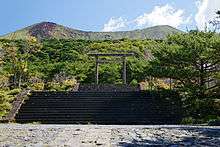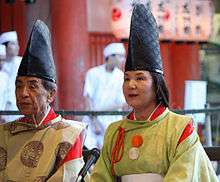শিন্তৌ ধর্ম
শিন্তৌ (শিন্তো) (জাপানি: 神道 শিন্তৌ "দেবতার পথ") জাপান রাষ্ট্র এবং জাপানি জাতির জাতীয় আধ্যাত্মিকতা এবং প্রচলিত ধর্ম। এটিকে আচারনির্ভর ধর্ম বলা হয়।[1] বিভিন্ন ধর্মীয় প্রথা এবং আচারের মাধ্যমে এই ধর্ম পালিত হয় যা বর্তমান এবং অতীতের মাঝে যোগসূত্র স্থাপন করেছে।[2] জাপানী পুরাণ খ্রিস্টের জন্মের ৬৬০ বছর পূর্বে শিন্তো ধর্ম উৎপত্তি লাভ করে[3] খ্রিষ্টীয় অষ্টম শতকে কোজিকি এবং নিহন শকি'র ঐতিহাসিক দলিলে শিন্তো আচারের কথা লিপিবদ্ধ আছে।


| শিন্তৌ ধর্ম |
|---|
| ধারাবাহিকের অংশ |
| অভ্যাস এবং বিশ্বাস |
|
| মঠ |
|
| উল্লেখযোগ্য কামি |
|
| গুরুত্বপূর্ণ সাহিত্য |
|
কোজিকি
|
| আরও দেখুন |
|
|
|
শিন্তো শব্দের আভিধানিক অর্থ হচ্ছে দেবতার পথ। শিন্তো শব্দটি শিন্দো শব্দ থেকে এসেছে।[4] শিন্ডো শব্দটির মূল খুঁজে পাওয়া যায় চীনা শব্দ শেন্ডো থেকে।[5] শিন্তো শব্দটি দুটি শব্দ নিয়ে গঠিত। শিন অর্থ ইংরেজী স্পিরিট বা আধ্যাত্বিক শক্তি এবং তো অর্থ পথ।[5][6]
শিন্তো জাপানের প্রধান ধর্ম। দেশটির ৮০% মানুষ বিভিন্ন ভাবে শিন্তো রীতিনীতি পালন করে কিন্তু আদমশুমারীর সময় খুব অল্প সংখ্যক লোক নিজেদেরকে শিন্তো ধর্মানুসারী বলে পরিচয় দেয়।[7] প্রকৃতপক্ষে, জাপানে শিন্তো একটি পরম্পরাগত ব্যাপার। এর মধ্যে প্রাতিষ্ঠানিক ভাবে শিন্ট ধর্মাবলম্বী হওয়ার মতো কোন ব্যাপার নেই । কিছু প্রথাগত বিশ্বাস এবং তার ভিত্তিতে বিশেষ বিশেষ উতসব অনুষ্ঠান উপলক্ষে শিন্ট ধর্মস্থান গুলিতে মানুষের জমায়েত হওয়া থেকেই সাখ্যাতা অনুমান করে নিতে হয় ।জাপানে ৮১০০০ শিন্ত ধর্মস্থান এবং ৮৫০০০ ধর্মগুরু রয়েছেন ।
আরও দেখুন
তথ্যসূত্র
- Williams, 2004. p. 6
- John Nelson. A Year in the Life of a Shinto Shrine. 1996. pp. 7–8
- "The True Religion Acceptable by God", p. 23, by St. Godbe Ajuzie
- Stuart D. B. Picken, 1994. p. xxi
- Sokyo, Ono (১৯৬২)। Shinto: The Kami Way (1st সংস্করণ)। Rutland, VT: Charles E Tuttle Co। পৃষ্ঠা 2। আইএসবিএন 0-8048-1960-2। ওসিএলসি 40672426।
- Richard Pilgrim, Robert Ellwood (১৯৮৫)। Japanese Religion (1st সংস্করণ)। Englewood Cliffs, New Jersey: Prentice Hall Inc। পৃষ্ঠা 18–19। আইএসবিএন 0-13-509282-5।
- "Association of Shinto Shrines | 設立"। Jinja Honcho। সংগ্রহের তারিখ ২০১৩-০৫-০৫।
আরো পড়ুন
- Averbuch, Irit (১৯৯৫)। The Gods Come Dancing: A Study of the Japanese Ritual Dance of Yamabushi Kagura। Ithaca, NY: East Asia Program, Cornell University। আইএসবিএন 1-885445-67-9। ওসিএলসি 34612865।
- Averbuch, Irit (১৯৯৮)। "Shamanic Dance in Japan: The Choreography of Possession in Kagura Performance"। Asian Folklore Studies। Nanzan Institute for Religion and Culture। 57 (2): 293–329। doi:10.2307/1178756। জেস্টোর 1178756।
- Blacker, Dr. Carmen (২০০৩)। "Shinto and the Sacred Dimension of Nature"। Shinto.org। ২০০৭-১২-২২ তারিখে মূল থেকে আর্কাইভ করা। সংগ্রহের তারিখ ২০০৮-০১-২১।
- Bowker, John W (২০০২)। The Cambridge Illustrated History of Religions। New York City: Cambridge University Press। আইএসবিএন 0-521-81037-X। ওসিএলসি 47297614।
- Breen, John; Teeuwen, Mark (২০১০)। A New History of Shinto। Blackwell। আইএসবিএন 1405155167।
- Breen, John and Mark Teeuwen, সম্পাদকগণ (২০০০)। Shintō in History: Ways of the Kami। Honolulu, Hi: Hawaii University Press। আইএসবিএন 0-8248-2362-1।
- Endress, Gerhild (১৯৭৯)। "On the Dramatic Tradition in Kagura: A Study of the Medieval Kehi Songs as Recorded in the Jotokubon"। Asian Folklore Studies। Nanzan Institute for Religion and Culture। 38 (1): 1–23। doi:10.2307/1177463। জেস্টোর 1177463।
- Engler, Steven; Grieve, Gregory P. (২০০৫)। Historicizing "Tradition" in the Study of Religion। Walter de Gruyter, Inc.। পৃষ্ঠা 92–108। আইএসবিএন 3110188759।
- Havens, Norman (২০০৬)। "Shinto"। Paul L. Swanson & Clark Chilson, (eds.)। Nanzan Guide to Japanese Religions। Honolulu, HI: University of Hawaii Press। পৃষ্ঠা 14–37। আইএসবিএন 978-0-8248-3002-1। ওসিএলসি 60743247।
- Herbert, Jean (১৯৬৭)। Shinto The Fountainhead of Japan। New York: Stein and Day।
- Inoue, Nobutaka et al. Shinto, a Short History (London: Routledge Curzon, 2003) online
- Kitagawa, Joseph Mitsuo (১৯৮৭)। On Understanding Japanese Religion। Princeton University Press। আইএসবিএন 0691102295।
- Kobayashi, Kazushige (১৯৮১)। "On the Meaning of Masked Dances in Kagura"। Asian Folklore Studies। Nanzan Institute for Religion and Culture। 40 (1): 1–22। doi:10.2307/1178138। জেস্টোর 1178138। অজানা প্যারামিটার
|coauthors=উপেক্ষা করা হয়েছে (|author=ব্যবহারের পরামর্শ দেয়া হচ্ছে) (সাহায্য) - Kuroda, Toshio, K.; James C. Dobbins; Gay, Suzanne (১৯৮১)। "Shinto in the History of Japanese Religion"। Journal of Japanese Studies। The Society for Japanese Studies। 7 (1): 1–21। doi:10.2307/132163। জেস্টোর 132163।
- Littleton, C. Scott (২০০২)। Shinto: Origins, Rituals, Festivals, Spirits, Sacred Places। Oxford, NY: Oxford University Press। আইএসবিএন 0-19-521886-8। ওসিএলসি 49664424।
- Picken, Stuart D. B. (১৯৯৪)। Essentials of Shinto: An Analytical Guide to Principal Teachings। Greenwood। আইএসবিএন 0313264317।
- Picken, Stuart D. B. (২০০২)। Historical Dictionary of Shinto। Lanham, Maryland, and London: The Scarecrow Press। আইএসবিএন 0-8108-4016-2।
- Ueda, Kenji (১৯৯৯)। "The Concept of Kami"। John Ross Carter (ed.)। The Religious Heritage of Japan: Foundations for Cross-Cultural Understanding in a Religiously Plural World। Portland, OR: Book East। পৃষ্ঠা 65–72। আইএসবিএন 0-9647040-4-8। ওসিএলসি 44454607।
- Williams, George; Bhar, Ann Marie B.; Marty, Martin E. (২০০৪)। Shinto (Religions of the World)। Chelsea House। আইএসবিএন 0791080978।
- Yamakage, Motohisa (২০০৭)। The Essence of Shinto, Japan's Spiritual Heart। Tokyo, New York, London: Kodansha International। আইএসবিএন 4-7700-3044-4।
বহিঃসংযোগ
| উইকিমিডিয়া কমন্সে শিন্তৌ ধর্ম সংক্রান্ত মিডিয়া রয়েছে। |
- Jinja Honcho – English—The Official Japanese Organization of 80,000 Shinto Shrines
- Kokugakuin University Encyclopedia of Shinto and its Japanese Shinto Jinja Database
- Chiga Yoshimi Gallery—The Scenery of Nara's Shrines and Temples which were drawn by Chiga Yoshimi.
- Tsubaki Grand Shrine of America—Tsubaki Grand Shrine of America: Jinja Shinto in North America, branch of Tsubaki Grand Shrine in Mie Japan
- Heian Jingu Shrine—Heian Shrine in Kyoto City was built in 1895 in commemoration of the 1100th anniversary of the move of Japanese Capital from Nara to Kyoto in 794.
- Meiji Jingu—Meiji Jingu Shrine in Yoyogi, Tokyo, commemorates Emperor Taisho and his wife Empress Shoken.
- Yasukuni Jinja—A shrine for the honoring of Japanese War Dead, English site.
- Shoin-Jinja—Shoin Shrine in Tokyo enshrines Yoshida Shoin, a spiritual leader of Meiji Restoration.
- Yushima Tenjin—A Tokyo Shrine with and English site—Shrine for Ameno-tajikaraono-mikoto and Sugawara Michizane.